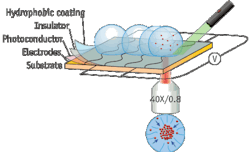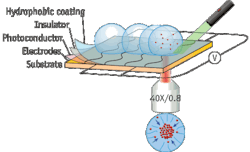Biosensing gets a boost from optoelectric approach
A method that uses a combination of light and electric fields to position droplets promises to enable medical diagnostics. Ordinarily, particles such as bacteria, viruses and DNA contained within droplets are detected when they randomly fall on the surface of a sensor. Developed at Purdue University (West Lafayette, IN), the optoelectric approach could improve sensor efficiency by actively moving particles to specific regions on an electronic chip for detection or analysis. "This new hybrid technique is universal in the sense that we can manipulate a range of droplet and particle sizes, going all the way from microliter drops to particles a few nanometers long," said Steven T. Wereley, professor of mechanical engineering at Purdue University, who partnered with doctoral student Aloke Kumar on the work.
Critical to the technology are electrodes made of indium tin oxide, a transparent and electrically conductive material commonly used in consumer electronics for touch-screen displays. Liquid drops are positioned on the electrodes, and an infrared laser heats up both the electrodes and the droplets. Then, electric fields in the electrodes cause the heated liquid to produce a "microfluidic vortex" of circulating liquid. This vortex enables researchers to position the particles in the circulating liquid by moving the infrared laser. The particles accumulate only where the laser is shined.
The Purdue approach uses a tightly focused infrared laser beam to position tiny particles, such as viruses and bacteria, onto a sensor. (Image courtesy Han-Sheng Chuang/Purdue University Birck Nanotechnology Center)
Kumar, lead author on a paper describing the work, said, "We should be able to improve the efficiency of sensors at least 10 times."
Sensors based on the technique could make possible a new class of chemical analyses, or assays, with point-of-care devices in a doctor's office or hospitals. Such sensors might be used to quickly analyze blood, urine and other bodily fluids for a range of applications, such as detecting coronary artery disease, tumors and various inherited diseases, including cystic fibrosis; and detecting infectious diseases and bacteria, viruses and fungi that are difficult to culture using conventional laboratory methods.
The technique is promising for DNA testing; for instance, forensics. "The idea is to use a chip to quickly carry out laboratory procedures called polymerase chain reaction and capillary electrophoresis. The new technology also should be good for testing food and water for pathogens such as E. coli or salmonella," said Wereley.
- Langmuir, 26 (11), 7656–7660, 2010.
More Brand Name Current Issue Articles
More Brand Name Archives Issue Articles

